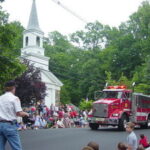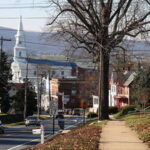A winter storm must meet certain qualifications to be characterized as an official blizzard. In a blizzard, visibility is reduced to a quarter of a mile or less from falling OR blowing snow, and the wind speed is at least thirty-five miles an hour for no less than three hours. Blizzards have struck without warning throughout the history of the United States, killing hundreds, stranding thousands, and demonstrating nature’s awesome power. From the blizzard generally regarded as the worst in our nation’s annals, the Blizzard of 1888, to the recent blizzard of 2006, these ferocious storms are capable of paralyzing entire sections of the country even today.
The Blizzard of 1888 has been called “The Great White Hurricane”, and for good reason. Starting on March 12th and ending on the 14th, this colossal blizzard left snow drifts in some places that were fifty feet high. The East Coast from Maryland to the Canadian Maritimes was absolutely brought to a stop by this blizzard. The existing telegraph system was destroyed, cutting the major cities off from the outside world for days. Two hundred ships were lost at sea or in harbors, and over one hundred seaman perished. Fire stations could not get their apparatus out onto the street, so the fire damage alone was estimated at over twenty five million dollars. New York City saw a hundred people die, and in all four hundred met their end during this blizzard. Fifty inches of snow fell in parts of Massachusetts and Connecticut, and the forty plus that blanketed New York caused the city to build their underground subway system to avoid future disasters such as this one.
Early in 1888, the deadly Schoolhouse Blizzard struck the Plains States from Texas to South Dakota, stranding school children in their one-room schoolhouses, hence the name. On January 12th, the temperatures were mild, but an incredible drop in the mercury brought the levels low enough so that it could snow. The gusting winds soon created whiteout conditions, where the ground could not be differentiated from the sky. About 235 people died, most of them school-aged kids on their way home that never realized they had no chance of traversing such conditions. Some froze to death where they fell, while others lost their lives to the effects of frostbite; some were not found until spring. One teacher actually tied a rope around her class of seventeen kids and led them to the safety of the house she lived in.
Snow was not the major feature of the Great Blizzard of 1899; it was the cold weather that set records from Montana to Florida. The cold wave extended all the way to Miami, where on February 14th the temperature fell to 29 degrees Fahrenheit. Sub-zero cold covered every state from Maine to Georgia, and a low-pressure system came up the East Coast with over a foot of snow in many places, with two to three feet in New England. New Orleans became iced over, and Tallahassee, Florida saw the thermometer read minus two, the only sub-zero temperature in Florida in recorded history.
In January of 1922, a blizzard covered Washington D. C. with over two feet of snow. The storm came to be called the Knickerbocker Storm because the weight of all this snow caved in the roof of the Knickerbocker Theatre, killing almost one hundred people in one of our capitol’s worst disasters. The fearsome Armistice Day Blizzard hit the Midwest on November 11th, 1940, and caught the entire region off guard. Warm temperatures turned bitterly cold in a matter of hours, the winds reached eighty miles an hour, and two feet of snow and freezing precipitation came down. Duck hunters on the rivers were trapped in their blinds, as the weather forecasters had totally whiffed on their predictions. Many froze on the islands they were trapped on and some drowned trying to get to safety. In all, one hundred and fifty four died in this blizzard, sixty-six of them sailors that went to their fate on three separate sinking freighters in Lake Michigan.
The Blizzard of 1978 was as bad as it gets in many northeastern states, with some receiving over fifty inches of snow. Hurricane force winds turned the entire Northeast into a white wasteland for days, as no amount of plows could possibly have kept pace with the snowfall. Over fifty people died in this storm, one a child who went outside his Massachusetts home just a few feet and wasn’t found until the snow melted. People died in their cars from carbon monoxide poisoning, trapped on the side of the road waiting to be rescued, while the snow blocked their exhausts. Fallen power lines caused many deaths and coastal flooding brought devastating erosion.
The 1996 Blizzard that gave Philadelphia its single greatest snowfall of thirty inches paralyzed the East Coast. Three of the last four years have seen powerful blizzards affect the Atlantic and New England States, and a blizzard just recently turned Denver, Colorado into the North Pole, making travel all but impossible. Blizzards are a part of the winter in this country, and the next great one could be just around the corner.





